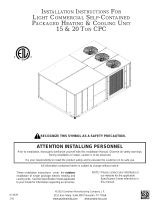
cycles, or if a suspected malfunction has occurred, check each
electrical component with the proper electrical instrumentation.
Refer to the unit wiring label when making these checkouts.
NOTE: Refer to the heating and/or cooling sequence of operation
in this publication as an aid in determining proper control
operation.
REFRIGERANT CIRCUIT-- Inspect all refrigerant tubing con-
nections and the unit base for oil accumulations annually. Detect-
ing oil generally indicates a refrigerant leak.
¥!_|VI'-I :qTIIT[_
System under pressure. Relieve pressure and recover all
refrigerant before system repair or final unit disposal to avoid
serious injury or death. Use all service ports and open all
flow-control devices, including solenoid valves.
r.,_lt'_ ;1:11:[
If oil is detected or if low cooling performance is suspected,
leak-test all refrigerant tubing using an electronic leak-detector.
halide torch, or liquid soap solution. If a refrigerant leak is
detected, refer to Check for Refrigerant Leaks section.
If no refrigerant leaks are found and low cooling performance is
suspected, refer to Checking and Adjusting Refrigerant Charge
section.
EVAPORATOR AIRFLOW- The heating and/or cooling air-
flow does not require checking unless improper performance is
suspected, ff a problem exists, be sure that all supply- and
retu_7l-air grilles are open and free from obstructions, and that the
air filter is clean. When necessary, refer to Indoor Airflow and
Airflow Adjustments section to check the system airflow.
METERING DEVICE ACCURATOR® PISTON--This me-
tering device is a fixed orifice and is contained in the brass
hex-body in the liquid line.
PRESSURE SWITCHES Pressure switches are protective de-
vices wired into control circuit (low voltage). They shut off
compressor if abnormally high or low pressures are present in the
refrigeration circuit. These pressure switches are specifically
designed to operate with Puron (R_-IOA) systems. R-22 pressure
switches must not be used as replacements for the Puron (R-
410A) air conditioner.
LOSS OF CHARGE/LOW-PRESSURE SWITCH (AIR CONDI-
TIONER ONLY)--This switch is located on the liquid line and
protects against low suction pressures caused by such events as
loss of charge, low airflow across indoor coil, dirty filters, etc. It
opens on a pressure drop at about 20 psig. If system pressure is
above this, switch should be closed.
To check switch:
I. Turn off all power to unit.
2. Disconnect leads on switch.
3. Apply ohmeter leads across switch. You should have conti-
nuity on a good switch.
NOTE: Because these switches are attached to refrigeration
system under pressure, it is not advisable to remove this device for
troubleshooting unless you are reasonably certain that a problem
exists. If switch must be removed, remove and recover all system
charge so that pressure gages read 0 psi. Never open system
without breaking vacuum with dry nitrogen.
HIGH-PRESSURE SWITCH--The high-pressure switch is lo-
cated in the discharge line and protects against excessive con-
denser coil pressure. It opens at 610 psig.
High pressure may be caused by a dirty condenser coil, failed fan
motor, or condenser air recircnlation.
[] [,_l//[,]: I
To check switch:
1. Turn off all power to unit.
2. Disconnect leads on switch.
3. Apply ohmeter leads across switch. You should have conti-
nuity on a good switch.
COPELAND SCROLL COMPRESSOR (PURON REFRIGER-
ANT -- The compressor used in this product is specifically
designed to operate with Puron (R-410A) refrigerant and
cannot be interchanged.
The compressor is an electrical (as well as mechanical) device.
Exercise extreme caution when working near compressors. Power
should be shut off. if possible, for most troubleshooting tech-
niques. Refrigerants present additional safety hazards.
Wear safety glasses and gloves when handling refrigerants.
Keep torches and other ignition sources away from refriger-
ants and oils. Failure to follow this warning can cause a fire,
serious injury, or death.
The scroll compressor pumps refrigerant throughout the system by
the interaction of a stationary and an orbiting scroll. The scroll
compressor has no dynamic suction or discharge valves, and it is
more tolerant of stresses caused by debris, liquid slugging, and
flooded starts. The compressor is equipped with an anti-rotational
device and an intemai pressure relief port. The anti-rotational
device prevents the scroll from turning backwards and replaces the
need for a cycle protector. The pressure relief port is a safety
device, designed to protect against extreme high pressure, the
relief port has an operating range between 550 and 625 psi
differential pressure.
The Copeland scroll compressor uses Mobil 3MA POE oil.
This is the only oil allowed for oil recharge.
REFRIGERANT SYSTEM
REFRIGERANT
19
This system uses Puron® (R_!IOA/ refrigerant which has
higher operating pressures than R-22 and other refrigerants.
No other refrigerant may be used in this system. Gage set,
hoses, and recovery system must be designed to handle
Puron. If you are unsure consult the equipment manufacturer.
Failure to use Puron compatible servicing equipment or
replacement components may result in property damage or
injury.
COMPRESSOR OIL--The compressor in this system uses a
polyolester (POE) oil, Mobil 3MA POE. This oil is extremely
hygroscopic, meaning it absorbs water readily. POE oils can
absorb 15 times as much water as other oils designed for HCFC
and CFC refrigerants. Take all necessary precautions to avoid
exposure of the oil to the atmosphere.
SERVICING SYSTEMS ON ROOFS WITH SYNTHETIC MA-
TERIALS POE (polyolester) compressor lubricants are known
to cause long term damage to some synthetic roofing materials.
Exposure, even if immediately cleaned up, may cause embrittle-
ment (leading to cracking) to occur in one year or more. When
performing any service that may risk exposure of compressor oil to
the roof, take appropriate precautions to protect roofing, proce-
dures which risk oil leakage include, but are not limited to,
compressor replacement, repairing refrigerant leaks, replacing
refrigerant components such as filter drier, pressure switch, me-
tering device, coil, accumulator, or reversing valve.




















